
I cycled from Lisbon to Lagos in Portugal September 2017 and was very struck by the very high quality of their public spaces. As public realm is a... ...
I cycled from Lisbon to Lagos in Portugal September 2017 and was very struck by the very high quality of their public spaces. As public realm is a phrase on every Planner’s lips, Portugal is certainly a case study worth examining. They have obviously made a significant investment in this pedestrian infrastructure and it repays a handsome dividend. Whereas their climate is more suited to al fresco living, there are some lessons which can be transferred. The careful arrangement of the smallest corner of every village is evident with attention to detail in geometry, landscaping, surfaces and furniture. Each space features a sculpture or a statue, and where blank gable walls bear down they are decorated with street art. Many of the spaces are raised by one step or even elevated above a vista, cityscape or beach-front. These terraces are very successful in forming a separate pedestrian realm from the street, and contradict current wisdom amongst Planners that Miesian podiums are exclusive and hostile additions to an urban environment. As to the climate, there is no reason why public spaces in Ireland cannot be covered from our inclement climate or at least the perimeters surrounded by arcades like the many squares in Madrid. I know the arcades in Mediterranean cities are created to shield from direct sunlight, but they could provide the same function in Ireland to deflect the rain.

The terrace in front of Lisbon Cathedral. Elevation above the street does not make it inaccesible or negative, it merely enhances the pastoral experience of being up there away from the cars.

Even the smallest side street in Lisbon is carefully arranged and laid out with a central reservation for covered tables and chairs. This photo taken from the top of the Elevador Victorian cast iron lift looking down on the street below.

This small exercise in another Lisbon side street is a very graphic example ; three car parking spaces are ceded to allow a small raised deck. This is a such a simple example of how a small breathing space can be inserted into a street dominated by on street car parking which adds nothing to the urban grain.

A flat roof is converted to a viewing deck on the winding road up to Castelo de S. Jorge.

One of the many pastoral courtyards in Museo Calouste Gulbenkian Gallery, Lisbon. A rare example of Modernist Architecture in the International Style succeeding.

Blank building gables which face onto public spaces in Lisbon are decorated with street art. This adds a great sense of fun to the urban experience.

Terrace cafés at Sintra, Portugal. On each level there are people everywhere and this is what it is all about. Amanda Burden, the genius Planner behind the New York High-Line Park, cites five criteria for the success of public space ; (I) other people, (ii) a reason to visit, (iii) comfortable, movable furniture, (iv) a sense of enclosure and (v) views to look out at.
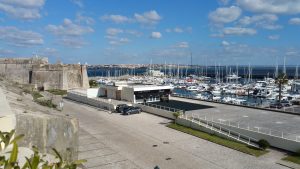
Raised pedestrian realm at Cascais, Portugal. Again the terraces are raised at various heights to improve the definition of the space, remove them from the road and optimise views. Note the limited on street car parking provision demoting the motor cars.
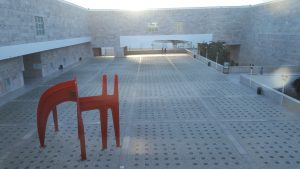
The central courtyard at Museo Colecao Berado, Lisbon. An interior space in a quadrangle building.

The same courtyard at Museo Colecao Berado, Lisbon, later that same evening.

Outside Museo Colecao Berado, Lisbon, the waterfront is a continuous and masterful public space which terminates at Belem Tower. This space arranged in steps washed by the tide is a very contemplative place to be at sunset.

Our cycle troop in Praca do Commercio or the primary civic square in Lisbon on the morning of Sunday the 24th September 2017, first day of our cycle.
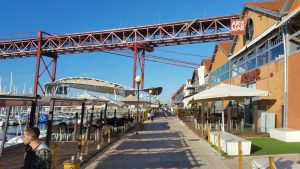
Even the quays in Lisbon are carefully set out in pedestrian pathways, terraces and seating areas. Here we are cycling towards the ferry.

This is the high point of Lisbon’s waterfront pedestrian sequence, the Vasco da Gama sculpture, as photographed from the ferry.

Lunch, Day One of the cycle, on an expansive terrace overlooking the beach at Sesimbra. Kids cycled, roller bladed and played football beside our table entertaining us.

Cycling through the tranquil Santuario de Nossa Senhora do Cabo Espichel.

Calçada Portuguesa or typical limestone cobble surface ; quaint, textured and natural, but a difficult surface to cycle on !

Day Four Lunch in a café on the beautiful piazza at Zambujeira Do Ma . . .

. . . . which of course overlooked the beach at Zambujeira Do Ma.

End of Day 4 of cycle, square after square of terraces and cafes in Monchique ; didn’t take this photo as the bike wobbles on the cobbles and we don’t stop.
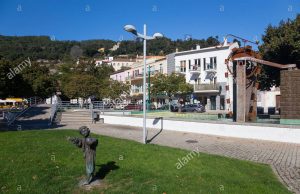
Central square of Monchique ; every public space includes a sculpture and or a statue.
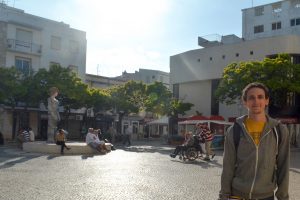
Day 5 of cycle ; arrive in Lagos. This is the shopping precinct. Lagos is a warren of pedestrian streets and a joy to wander.
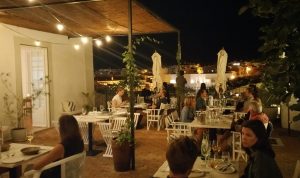
Last night in Lagos ; This is the terrace of Casa Mae, boutique hotel at the top of Lagos and inside one corner of the medieval city walls. What can you say ; great spaces.